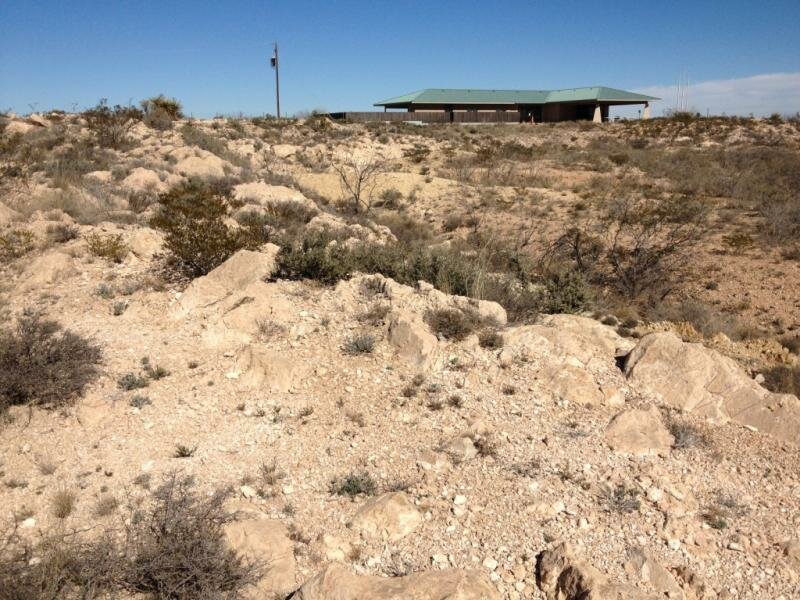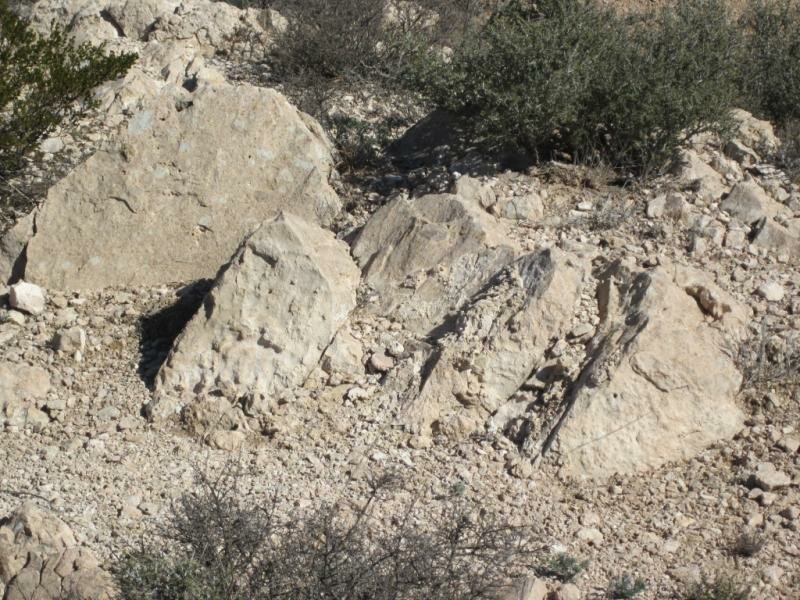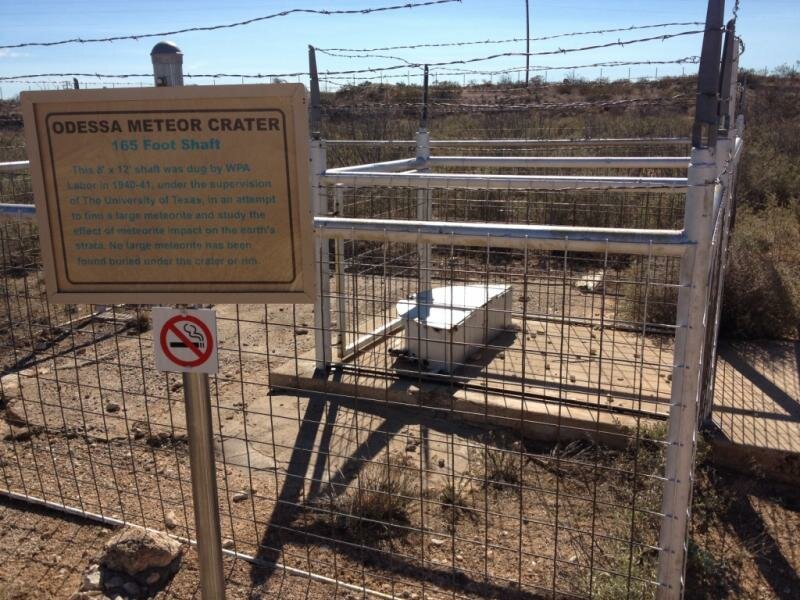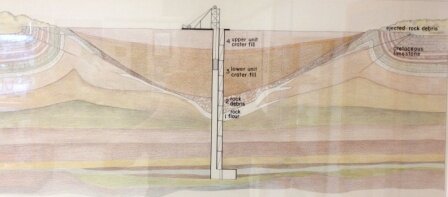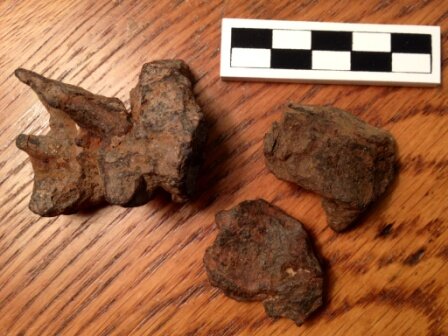United States Meteorite Impact Craters
- Home
- Crater Identification
- Alamo, Nevada
- Ames, Oklahoma
- Avak, Alaska
- Barringer, Arizona
- Beaverhead, Montana
- Chesapeake Bay, Virginia
- Cloud Creek, Wyoming
- Crooked Creek, Missouri
- Decaturville, Missouri
- Decorah, Iowa
- Des Plaines, Illinois
- Flynn Creek, Tennessee
- Glasford, Illinois
- Glover Bluff, Wisconsin
- Haviland, Kansas
- Kentland, Indiana
- Manson, Iowa
- Marquez, Texas
- Middlesboro, Kentucky
- Newporte, North Dakota
- Odessa, Texas
- Red Wing, North Dakota
- Rock Elm, Wisconsin
- Santa Fe, New Mexico
- Serpent Mound, Ohio
- Sierra Madera, Texas
- Upheaval Dome, Utah
- Weaubleau, Missouri
- Wells Creek, Tennessee
- Wetumpka, Alabama
- Possible Impacts
- User-submitted Possibles
- Open Questions
- About This Website
Odessa crater, Texas

Odessa Crater - Odessa is a group of 5 meteorite impact craters, the largest of which is 165 meters in diameter. The other 4 are substantially smaller. The Odessa craters are located about 10 miles southwest of the town of Odessa, Texas. The location is one of only a few craters in the world that are associated with recovered meteorites, and was one of the first meteorite craters recognized in North America (1920, by Barringer, of Canyon Diablo, AZ fame.).
Evidence of Impact Origin
The impact origin of each location listed on this website has been supported by unambiguous diagnostic evidence of hypervelocity impact that has been reported in a scientific (usually peer reviewed) context. Without such evidence, a geological structure is not a confirmed impact crater. This section, which is included for each crater on this website, is not an exhaustive list of such published evidence, but is meant to demonstrate that appropriate work has been done for each listing.
Evans and Mear, 2005
Nature of diagnostic evidence:
- There is overwhelming evidence that Odessa is an impact crater. It is a minimally weathered young crater with in-situ meteorite fragments within and around the crater in a pattern consistent with impact ejection. Sorrounding soil includes very small glassy impact melt fragments that contain a meteoritic component. The morphology of the site, which has been studied in great detail, is intact - with rock displacement completely consistent with a meteorite impact origin.
About the Odessa Impact Crater:
The early history of the crater is summarized in:
An excellent mueum is open to the public at the Odessa crater site. The museum contains a number of beautiful meteorites, interpretive and educational materials about the Odessa crater in specific and about meteorite impact craters in general, and impacted rocks from several other impact craters around the world. If you can make it by during the hours when the museum is open, it is definitely worth visiting. Affordable souvenirs, such as a t-shirt or coffee cup, support the educational facility.
The crater is in a gated area, but is open 7 days a week.
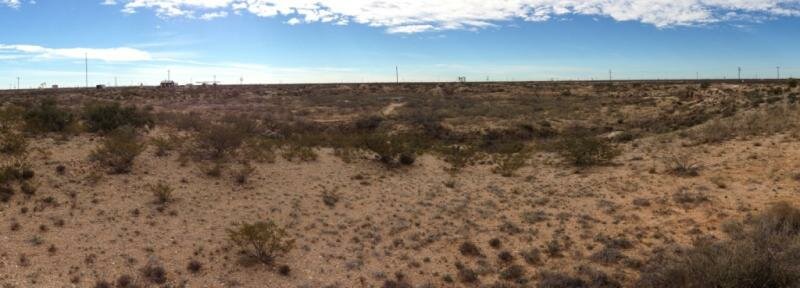
The crater is difficult to photograph from ground level. Great age, weathering, and excavation in the early 20th century have combined to reduce surface relief to no more than a few meters. Features are distinct, however, when viewed more closely from the well maintained trails that allow access to the crater rim and interior. These trails make this one of the world's better craters for easy viewing, while minimizing the destruction caused by heavy traffic. People are very strongly encouraged to stay on the trails, and this is not an idle concern. The structure is fragile, and there are a lot of rattle snakes in the region.
Interpretive signs point out specific features. This one marks clearly exposed up-tilted rocks in the rim of the main crater, shown in greater detail in the following two photos. A few of the older interpretive signs on the property list incorrect information, but are maintained for historical reasons.
The photo above gives a good sense of the scale of this structure. The small museum rests on the proximal ejecta blanket, just past the far rim of the crater. The image looks across the crater rim from about two thirds of the way around. The depressed region inside the crater is to the right, and the rim of raised rocks curving from the fore-ground off into the distance represents the explosively uplifted and outwardly shoved rocks of the crater rim.
The picture above is a detail of dramatically uplifted rocks in the crater rim. This is a typical feature of terrestrial meteorite impact craters, and the uplifting extends to vertical or overturned rocks in some instances. If the crater were fresh, instead of tens of thousands of years old, this displaced rim rock would be overlain by a substantial blanket of fallback ejecta explosively excavated from the crater interior. The slope outside of this rim, today, is the remnants of this continuous blanket of proximal ejecta.
The shaft excavated in the center of the crater during exploration in the first half of the 20th century is still present, and is fenced for public protection. This excavation, despite the limited publications that were produced from research at this site due to the outbreak of WWII shortly after work was completed, dramitically improved our understanding of crater structure and fill. A diagram hanging in the interpretive center, shown below, indicates the context of the excavated shaft within the crater, along with some of what it revealed about the structure and composition of the fill.
A description of this excavation, though not the illustration itself, can be found in Evans and Mear, 2000.
A second crater, about 21 meters across and nearly 6 meters deep, was found completely buried beneath the rim of the primary crater during exploration. It is nearly obliterated today, as trenches dug nearly 70 years ago were not backfilled, but sections of it remain intact in the walls of the original excavation shown above. Details of its excavation and of the massive fragments of meteorite found within it are found in Evans and Mear, 2000.
Many of the meteorite fragments found within the small 'crater 2' were heavily oxidized, like those shown here. Large meteorite masses remained in the smaller crater, since this portion of the impactor struck at lower velocity, but large masses did not remain in the primary crater. They were explosively ejected and scattered across the surrounding landscape. The remnants of 'crater 2' meteorites and the diagram of 'crater 2' shown here are in the interpretive center.
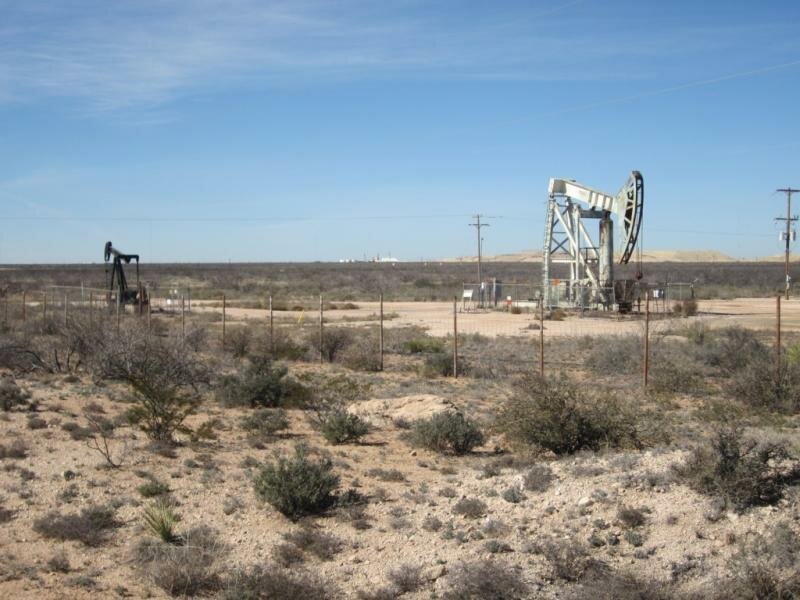
Old meteorites from the site are fairly common in the marketplace, however, and anyone that really wants one shouldn't have too hard a time finding them for sale. The impacting meteorite was an IAB-MG class Iron.

The crater site is easily accessed by visitors, with paved parking and access, picnic tables, and nearby lodgings in the towns of Odessa and Midland.
Bibliography and References:
(If links to articles don't work, don't give up. Try pasting the link shown into a search engine or searching for the article authors, title, or other reference information. If your research leads you to additional scientific references related to this crater, please help improve this resource by sending a note with the new citation(s) to: )
Barringer, B. (1967) Historical Notes on the Odessa Meteorite Crater. Meteoritics, volume 3, number 4, page 161-168.
Barringer, D. M. Jr. (1928) A new meteor crater. Proceedings of the Academy of Natural Sciences of Philadelphia, v. 80, pp. 307-311.
Beauford R. E. 2015. Indicators of impact origin in small terrestrial craters in Phyical Records of Impacts in The Early and Modern Solar System. Published doctoral dissertation (open access), University of Arkansas. Proquest Dissertations and Theses, Publication #3688247, pp: 84-152.
Beck, C. W. and LaPaz, L. (1951) The Odessa, Texas, Siderite (ECN=1025, 318). Popular Astronomy, v. 5, issue 17, pp. 27-33. DOI: 10.1111/j.1945-5100.1951.tb00165.x
Bibbins, A. B. (1926) A small meteor crater in Texas. Engineering and Mining Journal-Press, v. 121, no. 23, p. 932.
no link found
Boon, J.D. (1938) Established and supposed examples of meteoritic craters and structures: Field and Laboratory, volume 6, p. 44-56.
Boon, J. D. and Albritton, C. C. Jr. (1939 or 1940) Possibility of An Additional Meteorite Crater Near Odessa, Texas. Field and Laboratory, v. 8,, no. 1, pp. 11-18.
Brown, J. D. and Lipschutz, M. E. (1965) Electron-probe microanalysis of the Odessa iron meteorite. Icarus, volume, 4, issue 4, pp. 436-441.
Buchwald, V. F. (1975) Handbook of iron meteorites. University of California Press, Berkeley, volume 3, pp. 937-942.
index:
Buddhue, J. D. (1939), The Oxidation of Meteorites. Contributions of the Society for Research on Meteorites, volume 2, issue 5, pp. 75–79. doi: 10.1111/j.1945-5100.1939.tb00208.
Bunch, T. E. and Keil, K. (1969) Mineral compositions and petrology of silicate inclusions in iron meteorites: Chemistry of chromite in non-chondritic meteorites (abstract). Abstracts of the 1968 Meeting of the Meteoritical Society, Meteoritics, v. 4, no. 3, pp. 155-158.
Burnett, D. S. and Wasserburg, G. J. (1967) 87Rb-87Sr ages of silicate inclusions in iron meteorites. Earth and Planetary Science Letters, volume 2, issue 5, pp. 397-408. doi:10.1016/0012-821X(67)90180-X
Chen, J. H., Papanastassiou, D. A., Wasserburg, G. J. (2007) High precision nickel isotopic analysis in meteorites (abstract). Abstracts of the 38th Lunar and Planetary Science Conference.
Cloutis, E. A., Bailey, D. T., Craig, M. A., Hardersen, P. S. (2008) Reflectance Spectra of Iron Meteorite Powders (abstract). Abstracts of the 39th Lunar and Planetary Science Conference.
Cloutis, E. A., Hardersen, P. S., Bish, D. L., Bailey, D. T., Gaffey, M. J. and Craig, M. A. (2010) Reflectance spectra of iron meteorites: Implications for spectral identification of their parent bodies. Meteoritics & Planetary Science, volume 45, issue 2, pp. 304–332. doi: 10.1111/j.1945-5100.2010.01033.x
El Goresy, A., Ottemann, J. (1966) Gentnerite, Cu8Fe3Cr11S18, a new mineral from the Odessa meteorite. Zeitschrift für Naturforschung. A, Astrophysik, Physik und physikalische Chemie, Vol. 21a, p.1160-1161.
Evans, G. L. (1961) Investigations at the Odessa meteor craters. in Proceedings of the Geophysical Laboratory, Lawrence Radiation Laboratory Cratering Symposium, California University, Livermore, Lawrence Radiation Laboratory Report UCRL-6438, pt. 1, Paper D, pp. D1-11. (Report prepared for the U.S. Atomic Energy Commision)
no link found
Evans, G.L., and Mear, C.E., 2000, The Odessa meteor craters and their geological implications: Waco, Texas, Baylor University, Occasional Papers of the Strecker Museum 5, 50 p. This is the most in-depth publication on this crater. Evans and Mear, 2000, can be very difficult to find, but Baylor and a few other schools have copies that may be accessible through interlibrary loan. Hopefully, someone will eventually make a copy of this critical publication digitally available online.
Goel, P. S. (1962) Cosmogenic Carbon-14 and Chlorine-36 in meteorites, doctoral dissertation, Carnegie Institute of Technology, United States Atomic Energy Commision Report NYO–8922.
no link found - Barringer (1967) cites a C14 age of 11,000 yrs +- 4,000 yrs from this document.
Goldberg, E., Uchiyama, A. and Brown, H. (1957) The distribution of nickel, cobalt, gallium, palladium and gold in iron meteorites. Geochimica et Cosmochimica Acta, volume 2, issue 1, pp. 1-25. 1957. doi:10.1016/0016-7037(57)90088-1
Grant, J. A., Schultz, P. H. (1991) Characteristics of Ejecta and Alluvial Deposits at Meteor Crater, Arizona and Odessa Craters, Texas: Results From Ground Penetrating Radar (abstract). Abstracts of the 22nd Lunar and Planetary Science Conference, pp. 481-482.
Hardy, C. T. (1953) Structural dissimilarity of Meteor Crater and Odessa meteorite crater (abstract), American Association of Petroleum Geologists Bulletin., volume 37, issue 11, p. 2580.
Herzog, G. F., Lipschutz, M. E., Jain, A. V. and Rodman, T. E. (1976) Noble gases and shock effects in the Odessa octahedrite. Journal of Geophysical Research, volume 81, pp. 3583-3586. DOI: 10.1029/JB081i020p03583
Holliday, V. T., Kring, D. A., Mayer, J. H. and Goble, R. J. (2005) Age and effects of the Odessa meteorite impact, western Texas, USA. Geology, v. 33, no. 12, pp. 945-948.
or
data
ftp://rock.geosociety.org/pub/reposit/2005/2005185.pdf
Lang, B. and Franaszczuk, K. (1989) Fracture cascade for a meteorite at atmospheric entry: Canyon Diablo, Odessa, and Wolf Creek irons (abstract). Abstracts of the 19th Lunar and Planetary Science Conference, pp. 531-532.
Littlefield, D. L., Bauman, P. T. , Molineux, A., Analysis of formation of the Odessa crater, International Journal of Impact Engineering, 34, P. 1953 - 1961. 2007.
Lord, J. O. (1941), Metal Structures in Odessa, Texas, and Canyon Diablo, Arizona, Meteorites. Contributions of the Society for Research on Meteorites, volume 2, issue 7: 298–305. doi: 10.1111/j.1945-5100.1941.tb00296.x
Marshall, R. R. and Keil, K. (1965) Polymineralic inclusions in the Odessa iron meteorite. Icarus, volume 4, issue 5-6, pp. 461-479. doi:10.1016/0019-1035(65)90024-2
Massalski, T. B., and Park, F. R. (1962) A quantitative metallographic study of five octahedrite meteorites, Journal of Geophysical Research, volume 67, issue 7, 2925–2934. doi:10.1029/JZ067i007p02925
McHone, J F. and Dietz, R. S. (1992) Earth's multiple impact craters and astroblemes (abstract). Abstracts of the 23rd Lunar and Planetary Science Conference, pp. 887-888.
Merrill, G. P. (1922) Meteoric iron from Odessa, Ector County, Texas, American Journal of Science, volume series 5, volume 3, number 17, pp. 335-337. doi: 10.2475/ajs.s5-3.17.335
Monnig, O. E. and Brown, R. (1935) The Odessa, Texas, Meteorite Crater. Contributions of the Society for Research on Meteorites, Meteoritics and Planetary Science, volume 1, issue 1, pp. 1–4. doi: 10.1111/j.1945-5100.1935.tb00245.x
or
Nichiporuk, W. and Chodos, A. A. (1959) The concentration of vanadium, chromium, iron, cobalt, nickel, copper, zinc, and arsenic in the meteoritic iron sulphide nodules. Journal of Geophysical Research, volume 64, issue 12, pp. 2451-2463. doi:10.1029/JZ064i012p02451
Nininger, H. H. (1939) Odessa meteorite crater. The Sky, February, 1939, pp. 6-7; 23.
Nininger, H. H. (1934) The Odessa, Texas, Meteorite Crater. Popular Astronomy, volume 42, pp. 46-47.
Roach, C. H., Johnson, G. R., McGrath, J. G., Merritt, V. M., and Sterrett, T. S. (1963) Thermoluminescence investigations at the Odessa meteorite craters, Texas, in Astrogeologic Studies, Annual Progress Report, August 25, 1961, to August 24, 1962, U.S. Geological Survey Open-File Report 63-123, pt. B, p. 107-117.
no link found
Sellards, E. H. (1927) Unusual structural features in the plains region of Texas (abstract), Proceedings of the 39th Annual Meeting of the Geological Society of America, Geological Society of America Bulletin, volume 38, number 1, p. 149.
doi: 10.1130/GSAB-38-1
Sellards, E. H. (1934) Economic Geology of Texas (Exclusive of Petroleum), in The Geology of Texas, volume 2, Structural and Economic Geology. The University of Texas Bulletin, No. 3401, pp. 219-220.
http://www.lib.utexas.edu/books/landscapes/detail.php?oclc=555240-2
or
Sellards, E. H. and Barnes, V. E. (1940) Meteor crater of Ector county, Texas. Geological Society of America, 53rd Annual Meeting Excursions, pp. 129-130.
no link found - reference in (Barringer, B., 1967)
Sellards, E. H. (1940) Odessa meteor crater (abstract). Abstracts of the December meeting in Austin, Geological Society of America Bulletin, volume 51, no 12-2, p. 1944. doi: 10.1130/GSAB-51-1919
Sellards, E. H., (1941) Odessa meteor craters (abstract). Abstracts of the December meeting at Dallas, Geological Society of America Bulletin, volume 52, no 12-2, p. 2007, doi:10.1130/GSAB-52-1993
Sellards, E. H. and Barnes, V. E. (1943) Progress in excavating the Odessa, Texas, meteorite crater. Popular Astronomy, Vol. 51, p.224.
Sellards, E.H., and Evans, G.L., 1941, Statement of progress of investigation at Odessa meteor craters: Austin, University of Texas at Austin, Bureau of Economic Geology, 13 pages.
Shanos, G. T. (1997) The Odessa experience. Meteorite!, volume 3, pp. 16-17.
No link found.
Smith, T. R. and Hodge, P. W. (1999) Discovery of Impactite at the Odessa Meteorite Crater (abstract), Abstracts of the 60th Annual Meteoritical Society Meeting, Meteoritics, volume 34, issue S4, Supp. p. A122. doi: 10.1111/j.1945-5100.1999.tb01769.x
or
Smith, T. R. (1995) Impact crater particulates: Microscopic meteoritic material surrounding meteorite craters, PhD dissertation, University of Washington. 520 pages.
no link found
Smith, T. R. and Hodge, P. W. (1996) Microscopic Meteoritic Material at the Dalgaranga, Odessa and Veevers Meteorite Craters, Abstracts of the 27th Lunar and Planetary Science Conference. pp. 1223-1224.
Smith, T. and Hodge, P. (1993) Microscopic meteoritic material surrounding meteorite craters (abstract). Meteoritics, volume 28, issue 3, pp. 439. doi: 10.1111/j.1945-5100.1993.tb00269.
or
Strait, M. M. (1983) Just Another Piece of the Odessa Iron (abstract). Abstracts of Papers Presented at the 46th Annual Meeting of the Meteoritical Society, Meteoritics, volume 18, issue 4, p. 403. doi: 10.1111/j.1945-5100.1983.tb00194.x
or
Copyright 2011, 2012, 2013, 2014, 2015, 2016 United States Meteorite Impact Craters. All rights reserved.



